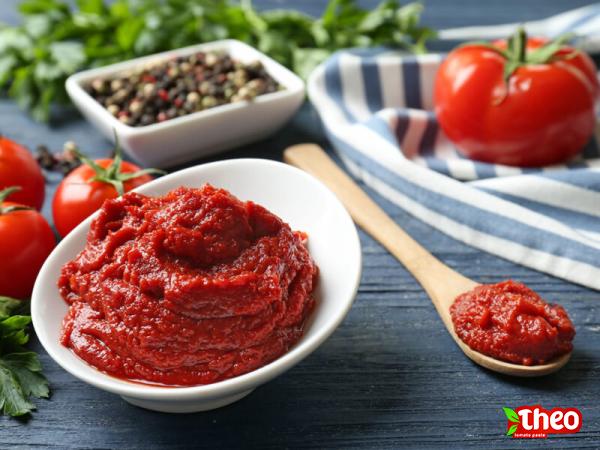Thickening Tomato Sauce: Exploring Alternative Methods without Tomato Paste Introduction: Tomato sauce is a versatile and flavorful addition to numerous cuisines and recipes around the world. While tomato paste is commonly used to thicken tomato sauce, there are various alternative methods available that can achieve similar results without relying on this ingredient. This article aims to explore different techniques to thicken tomato sauce without tomato paste, offering alternatives that can enhance the taste and texture of your dishes. 1. Simmering and Reducing: One of the simplest methods to thicken tomato sauce without tomato paste is by simmering and reducing the sauce. This technique involves slowly cooking the sauce over low heat, allowing the excess liquid to evaporate and the flavors to intensify. By reducing the sauce, you can achieve a thicker consistency while preserving the natural flavors of the tomatoes. This method works particularly well for chunky tomato sauces where some texture is desired. 2. Using Fresh Tomatoes: Another option for thickening tomato sauce without paste is by using fresh tomatoes. Instead of using canned tomato products or tomato paste, you can use ripe, juicy tomatoes as the base for your sauce. Fresh tomatoes contain natural pectin, a substance that can help thicken the sauce. Start by blanching and peeling the tomatoes, then cook them down to intensify the flavors while reducing the liquid content. This method results in a vibrant and flavorful tomato sauce. 3. Tomato Puree or Sauce: If you prefer a smoother texture for your tomato sauce, using tomato puree or sauce can be an excellent alternative to tomato paste. Tomato puree is made by blending cooked tomatoes, while tomato sauce is processed and strained without any added ingredients. These products are concentrated forms of fresh tomatoes and can add thickness to your sauce. Consider reducing the puree or sauce through simmering to further enhance the consistency.

tomato paste
 4. Cooking Down Vegetables: Adding vegetables to your tomato sauce not only provides extra flavor but can also contribute to its thickness. Ingredients such as onions, carrots, bell peppers, and mushrooms release moisture when cooked, helping to naturally thicken the sauce. Sauté these vegetables before adding the tomatoes, allowing them to release their juices and intensify their flavors. This method elevates the nutritional value of the sauce while achieving a thicker texture. 5. Incorporating Starchy Ingredients: Incorporating starchy ingredients into your tomato sauce can significantly aid in thickening it. Some popular options include potatoes, rice, or pasta. Cook the starchy ingredient of your choice until it is soft and then blend it with the sauce, either partially or entirely. The starch content in these ingredients will naturally thicken the sauce, providing a creamy and velvety texture. This method is particularly suitable for those looking for a gluten-free thickening option. 6. Vegetable Purees: Similar to incorporating starchy ingredients, adding vegetable purees to the tomato sauce can help thicken it without the need for tomato paste. Purees made from vegetables such as cauliflower, butternut squash, or zucchini can be used in small quantities to enhance both texture and flavor. These purees provide a creamy consistency while introducing an extra dimension of taste to your sauce. 7. Bread and Breadcrumbs: An unexpected yet effective thickening agent is the use of bread or breadcrumbs. This method is particularly popular in Mediterranean cuisine. Tear a few slices of stale bread, removing the crusts, and add them to the simmering tomato sauce. As the bread dissolves, it absorbs the liquid and releases starch, thickening the sauce. Similarly, you can use breadcrumbs by adding them directly to the sauce or by making a roux with butter and breadcrumbs as the base. 8. Roux: A classic technique used in French cuisine, a roux is a mixture of fat (usually butter) and flour cooked together. Adding a roux to tomato sauce can help thicken it while incorporating a rich, velvety texture. To make a roux, heat an equal amount of butter and flour in a pan until the mixture turns golden brown. Then, gradually stir the roux into the sauce until it reaches the desired thickness.
4. Cooking Down Vegetables: Adding vegetables to your tomato sauce not only provides extra flavor but can also contribute to its thickness. Ingredients such as onions, carrots, bell peppers, and mushrooms release moisture when cooked, helping to naturally thicken the sauce. Sauté these vegetables before adding the tomatoes, allowing them to release their juices and intensify their flavors. This method elevates the nutritional value of the sauce while achieving a thicker texture. 5. Incorporating Starchy Ingredients: Incorporating starchy ingredients into your tomato sauce can significantly aid in thickening it. Some popular options include potatoes, rice, or pasta. Cook the starchy ingredient of your choice until it is soft and then blend it with the sauce, either partially or entirely. The starch content in these ingredients will naturally thicken the sauce, providing a creamy and velvety texture. This method is particularly suitable for those looking for a gluten-free thickening option. 6. Vegetable Purees: Similar to incorporating starchy ingredients, adding vegetable purees to the tomato sauce can help thicken it without the need for tomato paste. Purees made from vegetables such as cauliflower, butternut squash, or zucchini can be used in small quantities to enhance both texture and flavor. These purees provide a creamy consistency while introducing an extra dimension of taste to your sauce. 7. Bread and Breadcrumbs: An unexpected yet effective thickening agent is the use of bread or breadcrumbs. This method is particularly popular in Mediterranean cuisine. Tear a few slices of stale bread, removing the crusts, and add them to the simmering tomato sauce. As the bread dissolves, it absorbs the liquid and releases starch, thickening the sauce. Similarly, you can use breadcrumbs by adding them directly to the sauce or by making a roux with butter and breadcrumbs as the base. 8. Roux: A classic technique used in French cuisine, a roux is a mixture of fat (usually butter) and flour cooked together. Adding a roux to tomato sauce can help thicken it while incorporating a rich, velvety texture. To make a roux, heat an equal amount of butter and flour in a pan until the mixture turns golden brown. Then, gradually stir the roux into the sauce until it reaches the desired thickness.
Specifications of tomato paste
 Conclusion: Tomato paste is commonly used to thicken tomato sauce, but there are numerous alternatives available for those seeking to explore different flavors and textures. By using methods such as simmering and reducing, utilizing fresh tomatoes, incorporating vegetable purees, starchy ingredients, breadcrumbs, or roux, you can achieve a thick and flavorful tomato sauce without relying on tomato paste. Experiment with these techniques to discover your preferred method and enhance your culinary creations.Using the Writing Principles of the English Language to Complete the Article: 1. The Rising Demand for Tomato-Based Products: Tomato-based products, including tomato sauce, have gained significant popularity in recent years. Consumers are increasingly looking for healthier and more natural alternatives to traditional processed foods. This trend has created opportunities for businesses to capitalize on the demand for high-quality, flavorful, and thick tomato sauces without relying on tomato paste. 2. Meeting Consumer Preferences: By exploring alternative methods to thicken tomato sauce without tomato paste, businesses can cater to a broader range of consumer preferences. Some individuals may have dietary restrictions or allergies that prevent them from consuming tomato products, such as tomato paste. Offering tomato sauces that are free from tomato paste can be a valuable selling point for health-conscious consumers. 3. Artisanal and Gourmet Market: The market for artisanal and gourmet products is on the rise, with consumers seeking unique and high-quality food experiences. By producing tomato sauces without tomato paste and using alternative thickening methods, businesses can differentiate themselves in this competitive market. Highlighting the use of fresh, natural ingredients and showcasing the versatility and complexity of the sauce can appeal to discerning customers. 4. Health Conscious Consumers: The health and wellness movement has had a significant impact on the food industry. Consumers are increasingly concerned about the ingredients used in their food and are actively seeking out products made with clean, natural ingredients. By offering tomato sauces without tomato paste, businesses can tap into this health-conscious market and position their products as nutritious and wholesome choices. 5. Customization and Personalization: Another advantage of exploring alternative methods to thicken tomato sauce is the opportunity to offer customization and personalization options to customers. Businesses can develop a range of tomato sauces with varying thicknesses to cater to different culinary preferences. Some individuals may prefer a thick, hearty sauce, while others may prefer a lighter, thinner consistency. By providing options, businesses can accommodate a wide range of tastes.
Conclusion: Tomato paste is commonly used to thicken tomato sauce, but there are numerous alternatives available for those seeking to explore different flavors and textures. By using methods such as simmering and reducing, utilizing fresh tomatoes, incorporating vegetable purees, starchy ingredients, breadcrumbs, or roux, you can achieve a thick and flavorful tomato sauce without relying on tomato paste. Experiment with these techniques to discover your preferred method and enhance your culinary creations.Using the Writing Principles of the English Language to Complete the Article: 1. The Rising Demand for Tomato-Based Products: Tomato-based products, including tomato sauce, have gained significant popularity in recent years. Consumers are increasingly looking for healthier and more natural alternatives to traditional processed foods. This trend has created opportunities for businesses to capitalize on the demand for high-quality, flavorful, and thick tomato sauces without relying on tomato paste. 2. Meeting Consumer Preferences: By exploring alternative methods to thicken tomato sauce without tomato paste, businesses can cater to a broader range of consumer preferences. Some individuals may have dietary restrictions or allergies that prevent them from consuming tomato products, such as tomato paste. Offering tomato sauces that are free from tomato paste can be a valuable selling point for health-conscious consumers. 3. Artisanal and Gourmet Market: The market for artisanal and gourmet products is on the rise, with consumers seeking unique and high-quality food experiences. By producing tomato sauces without tomato paste and using alternative thickening methods, businesses can differentiate themselves in this competitive market. Highlighting the use of fresh, natural ingredients and showcasing the versatility and complexity of the sauce can appeal to discerning customers. 4. Health Conscious Consumers: The health and wellness movement has had a significant impact on the food industry. Consumers are increasingly concerned about the ingredients used in their food and are actively seeking out products made with clean, natural ingredients. By offering tomato sauces without tomato paste, businesses can tap into this health-conscious market and position their products as nutritious and wholesome choices. 5. Customization and Personalization: Another advantage of exploring alternative methods to thicken tomato sauce is the opportunity to offer customization and personalization options to customers. Businesses can develop a range of tomato sauces with varying thicknesses to cater to different culinary preferences. Some individuals may prefer a thick, hearty sauce, while others may prefer a lighter, thinner consistency. By providing options, businesses can accommodate a wide range of tastes.
buy tomato paste
 6. Culinary Applications and Recipe Development: Businesses that produce tomato sauces without tomato paste can also explore various culinary applications and recipe development. Without the constraint of relying on tomato paste as a thickening agent, chefs and home cooks can experiment with different ingredients and techniques to create unique dishes. This opens up possibilities for collaborations with chefs, food bloggers, and influencers to showcase the versatility of the sauce in different recipes. 7. Marketing and Branding: By focusing on the use of alternative methods to thicken tomato sauce without tomato paste, businesses can develop effective marketing strategies that highlight the uniqueness of their products. Emphasizing the natural and artisanal aspects of the sauce can resonate with consumers who are looking for authentic and high-quality food options. Using storytelling techniques and showcasing the journey from fresh ingredients to the finished product can help build a strong brand image. 8. Partnerships with Local Farmers: Producing tomato sauces without tomato paste presents an opportunity for businesses to establish partnerships with local farmers. Sourcing fresh tomatoes directly from farmers can ensure the highest quality ingredients while supporting the local agricultural community. This can be a compelling selling point for consumers who are concerned about the provenance and sustainability of their food. 9. Product Differentiation in the Market: The market for tomato-based products can be crowded and competitive. By offering tomato sauces without tomato paste, businesses can differentiate themselves from competitors. Consumers are always looking for new and innovative products that offer unique flavors and textures. By focusing on alternative methods of thickening tomato sauce, businesses can position themselves as pioneers and stand out in a saturated market. 10. Capitalizing on Ethnic Cuisines: Ethnic cuisines, such as Italian, Mexican, and Mediterranean, heavily rely on tomato-based sauces in their traditional dishes. By offering tomato sauces without tomato paste, businesses can tap into the growing demand for authentic ethnic flavors. Catering to the specific requirements of these cuisines, such as providing gluten-free or vegan options, can open up new avenues and partnerships within the culinary industry. 11. Consumer Education and Engagement: Businesses that produce tomato sauces without tomato paste can take advantage of consumer education and engagement opportunities. Creating informative content about the benefits of using alternative thickening methods and sharing recipes and cooking tips can help build brand loyalty and trust. Engaging with customers through social media platforms, cooking demonstrations, and workshops can further deepen the connection and create a loyal customer base. 12. Sustainable Packaging and Production: Lastly, producing tomato sauces without tomato paste aligns with the growing demand for sustainable and eco-friendly practices in the food industry. Businesses can explore options for sustainable packaging and ensure they adhere to environmentally conscious production processes. This commitment to sustainability can resonate with consumers who prioritize eco-friendly choices and contribute positively to the brand image. Conclusion: As the market for tomato-based products continues to evolve, businesses that explore alternative methods to thicken tomato sauce without tomato paste can tap into a range of opportunities. From meeting the demands of health-conscious consumers to capitalizing on the rising gourmet and artisanal market, there are numerous benefits to developing and marketing tomato sauces without relying on tomato paste. By leveraging the versatility of fresh ingredients, customizing products, engaging with consumers, and promoting ethical and sustainable practices, businesses can position themselves as leaders in the industry and cater to a diverse customer base.
6. Culinary Applications and Recipe Development: Businesses that produce tomato sauces without tomato paste can also explore various culinary applications and recipe development. Without the constraint of relying on tomato paste as a thickening agent, chefs and home cooks can experiment with different ingredients and techniques to create unique dishes. This opens up possibilities for collaborations with chefs, food bloggers, and influencers to showcase the versatility of the sauce in different recipes. 7. Marketing and Branding: By focusing on the use of alternative methods to thicken tomato sauce without tomato paste, businesses can develop effective marketing strategies that highlight the uniqueness of their products. Emphasizing the natural and artisanal aspects of the sauce can resonate with consumers who are looking for authentic and high-quality food options. Using storytelling techniques and showcasing the journey from fresh ingredients to the finished product can help build a strong brand image. 8. Partnerships with Local Farmers: Producing tomato sauces without tomato paste presents an opportunity for businesses to establish partnerships with local farmers. Sourcing fresh tomatoes directly from farmers can ensure the highest quality ingredients while supporting the local agricultural community. This can be a compelling selling point for consumers who are concerned about the provenance and sustainability of their food. 9. Product Differentiation in the Market: The market for tomato-based products can be crowded and competitive. By offering tomato sauces without tomato paste, businesses can differentiate themselves from competitors. Consumers are always looking for new and innovative products that offer unique flavors and textures. By focusing on alternative methods of thickening tomato sauce, businesses can position themselves as pioneers and stand out in a saturated market. 10. Capitalizing on Ethnic Cuisines: Ethnic cuisines, such as Italian, Mexican, and Mediterranean, heavily rely on tomato-based sauces in their traditional dishes. By offering tomato sauces without tomato paste, businesses can tap into the growing demand for authentic ethnic flavors. Catering to the specific requirements of these cuisines, such as providing gluten-free or vegan options, can open up new avenues and partnerships within the culinary industry. 11. Consumer Education and Engagement: Businesses that produce tomato sauces without tomato paste can take advantage of consumer education and engagement opportunities. Creating informative content about the benefits of using alternative thickening methods and sharing recipes and cooking tips can help build brand loyalty and trust. Engaging with customers through social media platforms, cooking demonstrations, and workshops can further deepen the connection and create a loyal customer base. 12. Sustainable Packaging and Production: Lastly, producing tomato sauces without tomato paste aligns with the growing demand for sustainable and eco-friendly practices in the food industry. Businesses can explore options for sustainable packaging and ensure they adhere to environmentally conscious production processes. This commitment to sustainability can resonate with consumers who prioritize eco-friendly choices and contribute positively to the brand image. Conclusion: As the market for tomato-based products continues to evolve, businesses that explore alternative methods to thicken tomato sauce without tomato paste can tap into a range of opportunities. From meeting the demands of health-conscious consumers to capitalizing on the rising gourmet and artisanal market, there are numerous benefits to developing and marketing tomato sauces without relying on tomato paste. By leveraging the versatility of fresh ingredients, customizing products, engaging with consumers, and promoting ethical and sustainable practices, businesses can position themselves as leaders in the industry and cater to a diverse customer base.




